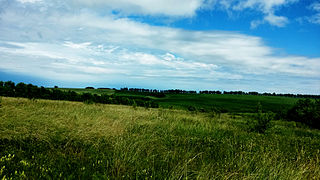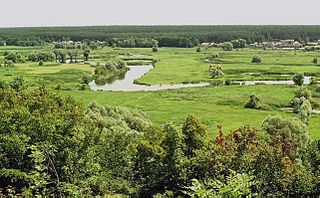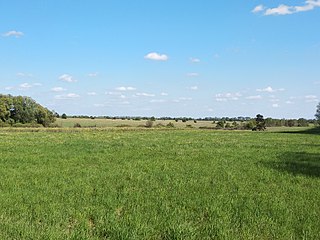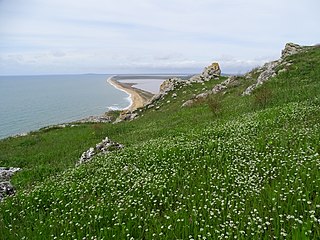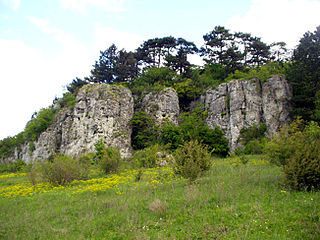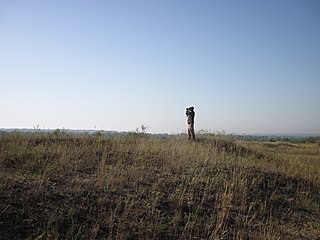List
| Name | Photo | Location | Website | Area | Year | Description |
|---|---|---|---|---|---|---|
| Gorgany |  | Ivano-Frankivsk Oblast 48°27′09″N24°14′00″E / 48.45250°N 24.23333°E | Reserve: | 5,344 ha (20.6 sq mi) | 1996 | Covers a part of the Gorgany mountain range of the Outer Eastern Carpatians in southwest Ukraine. The reserve is 46% old-growth forest, one of the last and largest such stands in Europe. [1] |
| Dniprovsko-Orilskyi |  | Dnipropetrovsk Oblast 48°30′43″N34°47′4″E / 48.51194°N 34.78444°E | Reserve: No URL | 3,766 ha (14.5 sq mi) | 1990 | Located in the center of the country in the valley of the Dnieper River, the reserve protects two river terraces, the first a strip 2 km wide along the left bank of the Dnieper, and the second a higher inland terrance. It also covers a floodplain of the Oril River. 30% of the reserve is water (some of which was backed up during construction of the Dnieper Hydroelectric Station), and 89% of the floodplain land is forest, mostly oak. |
| Drevlyans |  | Zhytomyr Oblast 51°12′10″N29°4′53″E / 51.20278°N 29.08139°E | Reserve: | 66,816 ha (258.0 sq mi) | 2009 | follows along the Uzh River in the Polesia region of north-central Ukraine. Created to protect representative forests and wetlands of the Polesia region, the area experienced contamination from the Chernobyl disaster. The site is 80 km due west of Chernobyl. [2] |
| Yelanets Steppe |  | Mykolaiv Oblast 47°38′05″N31°54′30″E / 47.63472°N 31.90833°E | Reserve: | 1,675.7 ha (6.5 sq mi) | 1996 | Covers a section of the largest virgin steppe tract in the Northern Black Sea Coast area. It is the only steppe reserve in Right-bank Ukraine (the area on the west side of the Dnieper River). [3] |
| Kaniv |  | Cherkasy Oblast 49°44′40″N31°27′21″E / 49.74444°N 31.45583°E | Reserve: | 2,027 ha (7.8 sq mi) | 1923 | Covers a portion of the right bank of the Dnieper River, and two floodplain islands in the river itself. The reserve is in the center of Ukraine, along the northeast edge of the Dnieper Upland. It was created to protect valuable forest-steppe and floodplain habitat. The site is known for an abundance of archaeological sites left by cultures back to the Paleolithic. [4] |
| Karadag |  | Crimea 44°56′09″N35°13′59″E / 44.93583°N 35.23306°E | Reserve: | 2,874 ha (11.1 sq mi) | 1979 | Covers a portion of the southeast coast of the Crimean peninsula. Encompassing mountains, forest-steppe, shoreline and marine areas, Karadag is an area of high biodiversity and the subject of much scientific study throughout the past 100 years. It supports a high number of Crimea's endemic species, and important bird colonies. [5] |
| Kazantypskyi |  | Crimea 45°27′42″N35°50′36″E / 45.4616°N 35.8434°E | Reserve: None | 4,500 ha (17.4 sq mi) | 1998 | Includes both territory of Cape Kazantyp and coast-aquatic-complex, on the Kerch Peninsula. [6] |
| Crimean |  | Crimea 44°40′00″N34°21′00″E / 44.66667°N 34.35000°E | Reserve: http://zapovednik-crimea.udprf-crimea.com/ | 44,175 ha (170.6 sq mi) | 1991 | Located on a portion of the Crimean Mountains, on the south coast of the Crimean Peninsula. It is the largest and oldest nature reserve in Ukraine [7] |
| Swan Islands |  | Crimea 45°52′30″N33°32′30″E / 45.87500°N 33.54167°E | Reserve: | 9,612 ha (37.1 sq mi) | 1949 | The Swan Islands Reserve protects a series of islands off the northwest coast of the Crimean Peninsula that this an important resting place for migratory birds in the summer and fall, and a nesting place in winter. It is a sub-unit of the Crimean Nature Reserve. [8] |
| Luhansk | 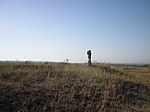 | Luhansk Oblast 48°45′06″N39°22′32″E / 48.75167°N 39.37556°E | Reserve: None | 8,000 ha (30.9 sq mi) | 1968 | Luhansk Nature Reserve is an administrative collection of four individual national nature reserves of Ukraine. Located in Luhansk Oblast, the easternmost province of Ukraine, the Luhansk reserves were affected by hostilities in the area in 2014. Originally established as a strict reserve for conservation and scientific study, public access is prohibited. The four components each exhibit a different aspect of the steppe ecology of eastern Ukraine. |
| Stanichno-Luhansk |  | Luhansk Oblast 48°45′25″N39°21′30″E / 48.75694°N 39.35833°E | Reserve: | 498 ha (1.9 sq mi) | 1968 | Covers a portion of the left bank of the Donets River floodplain. The reserve is about 30 km north of Luhansk, near the town of Stanytsia Luhanska. [9] |
| Provallya Steppe |  | Luhansk Oblast 48°09′01″N39°51′29″E / 48.15028°N 39.85806°E | Reserve: | 588 ha (2.3 sq mi) | 1975 | Covers two tracts of representative steppe on the eastern Ukrainian border with Russia. As of 2014, the reserve was no longer under the control of the Ukraine government. [10] |
| Striltsevsky Steppe |  | Luhansk Oblast 49°17′59″N40°5′46″E / 49.29972°N 40.09611°E | Reserve: | 1,037 ha (4.0 sq mi) | 1948 | Covers representative steppe habitat in eastern Ukraine. The site has been a nature reserve since 1931, providing scientists with a long history of study of steppe ecological processes. It is known for its population of European Marmot. [11] |
| Medobory |  | Ternopil Oblast 49°12′00″N26°10′00″E / 49.20000°N 26.16667°E | Reserve: | 10,521 ha (40.6 sq mi) | 1990 | Located in the Podolian Upland in the western part of the country. It protects a representative portion of the "Tovtry" region, known for rocky limestone ridges. [12] |
| Cape Martyan | 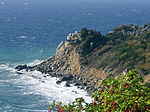 | Crimea 44°30′25″N34°15′03″E / 44.5068713°N 34.2508710°E | Reserve: None | 240 ha (0.9 sq mi) | 1973 | The reserve was created to save naturally valuable systems of Cape Martyan in natural state, to protect and to preserve rare species of flora and fauna, and to conduct scientific research. |
| Michael's Virgin Land |  | Sumy Oblast 50°55′N34°45′E / 50.917°N 34.750°E | Reserve: None | 883 ha (3.4 sq mi) | 2009 | Covers meadow-steppe and forest-steppe in the northeast of Ukraine near the border with Russia. It exhibits plants found in both northern and southern steppes. First created as a reserve in 1928, it was expanded over the years and formally upgraded to a national reserve in 2009. [13] |
| Opuksky |  | Crimea 45°01′50″N36°11′10″E / 45.03056°N 36.18611°E | Reserve: | 1,592 ha (6.1 sq mi) | 1998 | Located on the southern coast of the Kerch Peninsula on the Black Sea. It is centered on a limestone massif (Mount Opuk) rising from the kerch plains, and a salt lake (Lake Koyashske). The site is a Ramsar Wetland of International Importance. [14] |
| Polissya |  | Zhytomyr Oblast 51°32′05″N28°06′20″E / 51.53472°N 28.10556°E | Reserve: | 20,104 ha (77.6 sq mi) | 1968 | Dedicated to the conservation and scientific study of representative woodland marshes of the Pinsk Marshes in the Polissya region. [15] |
| Rivne |  | Rivne Oblast 51°23′40″N26°50′50″E / 51.3944°N 26.8472°E | Reserve: | 42,289 ha (163.3 sq mi) | 2003 | This is the largest area Ukraine has taken under protection, and the best preserved area of bog massifs. The reserve was created to preserve the natural state of typical and unique natural complexes of the Ukraine Polissya. As a result of Ukraine's geographical position, the reserve belongs to the Volyn Polissya zone of mixed forests. |
| Cheremske | 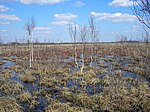 | Volyn Oblast 51°22′25″N25°28′40″E / 51.37361°N 25.47778°E | Reserve: None | 2,976 ha (11.5 sq mi) | 2001 | Covers forest and wetlands of the Western Polesia region, in the northwest of the country. The area is one of high biodiversity because of the varied habitat in transitional ecological zones. [16] |
| Ukrainian Steppe |  | Donetsk Oblast 47°06′N38°00′E / 47.100°N 38.000°E | Reserve: | 2,768 ha (10.7 sq mi) | 1961 | Protects a collection of primitive steppe tracts in Donetsk Oblast region of the Ukrainian southeast. Each tract is a different sub-type of Ukrainian steppe. [17] |
| Chalk Flora |  | Donetsk Oblast 48°52′23″N37°53′09″E / 48.87306°N 37.88583°E | Reserve: | 1,134 ha (4.4 sq mi) | 1988 | Lies on open chalk slopes of the riverine hills along the Donets River. The ridge is about 50–70 meters above the surrounding territory, and steep - up to 70 degrees. [18] |
| Yalta Mountain-Forest |  | Crimea 44°27′29″N34°05′24″E / 44.45806°N 34.09000°E | Reserve: | 14,523 ha (56.1 sq mi) | 1973 | Covers the southwestern ranges of the Crimean Mountains, along the south coast of the Crimean Peninsula. [19] |

